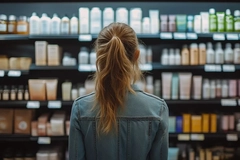Estée Lauder leads investigation into dermal hydration and UV damage research
.jpg)
19 Jun 2023 --- The Estée Lauder Companies (ELC) has collaborated with scientists at Aveda and the Lab Series brands to produce new insights on the “priority areas” in skin and hair care. Skin hydration, oxidative damage, scalp aging, men’s skin care and clinical methods for assessing treatments for UV damage are among some of the listed priority areas of research.
“At ELC, we continue to take a multidisciplinary scientific approach to skin and hair care, utilizing knowledge and advancements from across industries and the scientific community,” remarks Dr. Bhushan Hardas, SVP of advanced technologies.
The collaboration is aiming to produce new “transformative and locally-relevant” commercialized products.
The findings were presented at the 2023 Meeting of the International Societies of Investigative Dermatology (ISID) in Tokyo, Japan, where dermatology and skin science clinicians and researchers from around the globe gather.
Rice power for skin barrier function
At one ISID conference hosted by ELC, titled “Skin barrier function and approaches for improving innate hydration of the skin,” Japanese dermatologists presented research on the skin barrier system while speaking about the new moisturizing ingredient Rice Power 11α.
 Rice as a staple skin care ingredient has expanded in its use cases over this past year.Rice as a staple skin care ingredient has expanded in its use cases over this past year, with notable developments including the growing popularity of kojic acid – derived from fermenting rice proteins – and discovery of new forms of peptides derived from the food source.
Rice as a staple skin care ingredient has expanded in its use cases over this past year.Rice as a staple skin care ingredient has expanded in its use cases over this past year, with notable developments including the growing popularity of kojic acid – derived from fermenting rice proteins – and discovery of new forms of peptides derived from the food source.
Rice Power 11α was created in partnership with Dr. Yuichi Miyoshi of Yushin Brewer, the Estée Lauder brand, and ELC’s APAC and China R&D teams.
In vitro and in vivo studies have proven the hydration benefits of Rice Power 11α and dipotassium glycyrrhizinate-containing formulations, highlights ELC. “This research showed additional data on innate hydration improvement and anti-aging benefits of a formula leveraging rice fermentation technology.”
The results demonstrated that formulations using the technology could boost hyaluronic acid production and protect this compound from degradation.
Clinically, the treatments not only alleviated skin dryness, but also exhibited “strong benefits” toward anti-aging.
Simulating solar radiation-induced skin inflammation
ELC clinical researchers also presented findings from a study that induced skin inflammation across various skin types. This was measured by dynamic optical coherence tomography and a laser Doppler vibrometer.
“Clinical researchers performed a study to determine how the skin of people with different phototypes responds to different amounts of UV light and study the kinetics and effects of a standard treatment for inflammation,” details ELC.
The results showed that more UV light is required to cause inflammation for people with darker skin types than those with lighter skin types.
The study also has the potential to help with choosing the correct dosing of UV light for product testing and developing and evaluating treatments for different skin phototypes.
Estée Lauder brand scientists also presented research on the intracellular pH (pHi) of cells and a new extract they have developed that helps keep pHi in a normal range.
 ELC research found that more UV light is required to cause skin inflammation for people with darker skin types than those with lighter skin.They note that pHi can be affected by external factors such as UV light, pollution and blue light, resulting in cell damage, and ELC’s new extract can help protect cells from this type of damage.
ELC research found that more UV light is required to cause skin inflammation for people with darker skin types than those with lighter skin.They note that pHi can be affected by external factors such as UV light, pollution and blue light, resulting in cell damage, and ELC’s new extract can help protect cells from this type of damage.
Energizing men’s skin
Skin needs energy for proper skin recovery and ELC research has revealed that a combination of resveratrol-salicylate and niacinamide lowers oxidative damage that could result in a weaker, energy-deprived skin barrier.
When cells run low on energy, AMPK, an enzyme that regulates homeostasis and metabolism, is activated to help address our cells’ energy demands, and as we age, AMPK starts to decline.
“The combination also aids in producing higher levels of energy by increasing and supplying the cells with energy-activating molecules like NADH and ATP, while also activating the nutrient-sensing salvage pathway of AMPK to support skin in faster recovery and repair,” details ELC.
Studying the scalp
Aveda scientists presented a study on three different types of scalp skin cells to better understand global age-related changes observed on the female scalp.
The study found that the cells showed a “loss of cell signature and identity” with age and suggests that changes to these cells affect the ability of the scalp dermal environment to support and maintain healthy hair follicles.
A second Aveda presentation compared the proteomic profile of primary cultures of dermal fibroblasts, dermal sheath and dermal papilla cells from female donors of different age groups.
The research showed significant, differential differences in protein expression related to age and indicates that their identity is significantly altered with age.
Estée Lauder Companies business highlights
Earlier this month, ELC kicked off the second edition of its India-focused program to scale new beauty start-up businesses, called Beauty&You.
The first program was introduced last year to new and emerging brands. With over 300 entries across 50 Indian cities, the application pool included various beauty brands across skin and hair care, fragrance and color cosmetics.
The group also recently reported net sales of US$3.75 billion for its third quarter ended March 31, 2023, a decline of 12% from US$4.25 billion in the prior-year period. Company stocks fell 17.34% in May although its fragrance category grew double digits.
The beauty titan also completed its acquisition of the Tom Ford brand last month, in a deal that values the total enterprise at US$2.8 billion.
By Benjamin Ferrer












